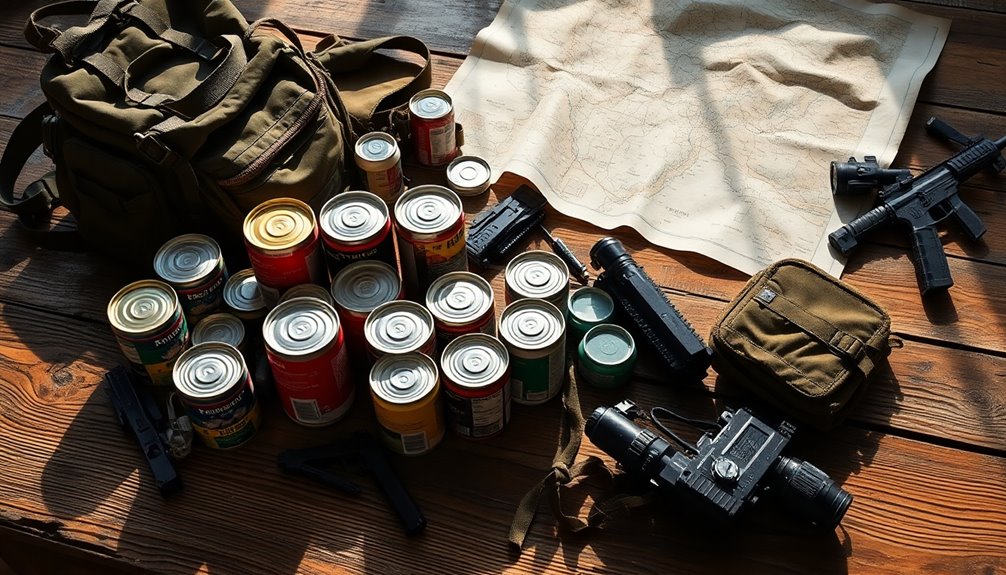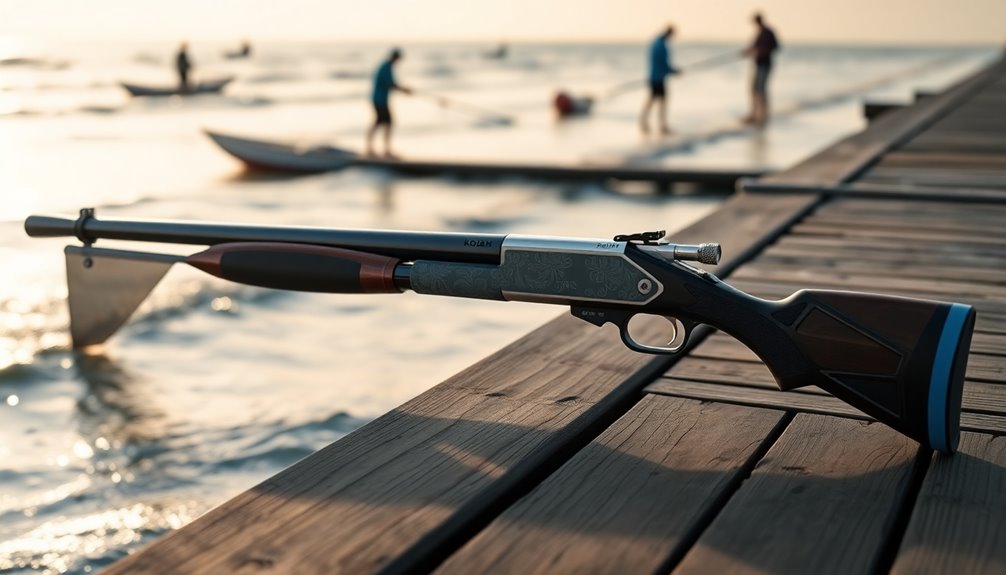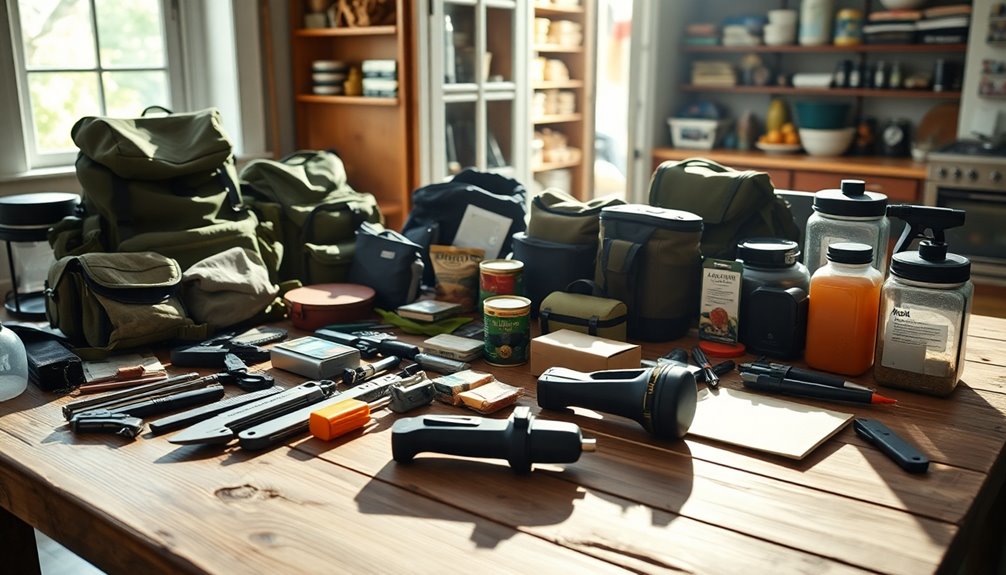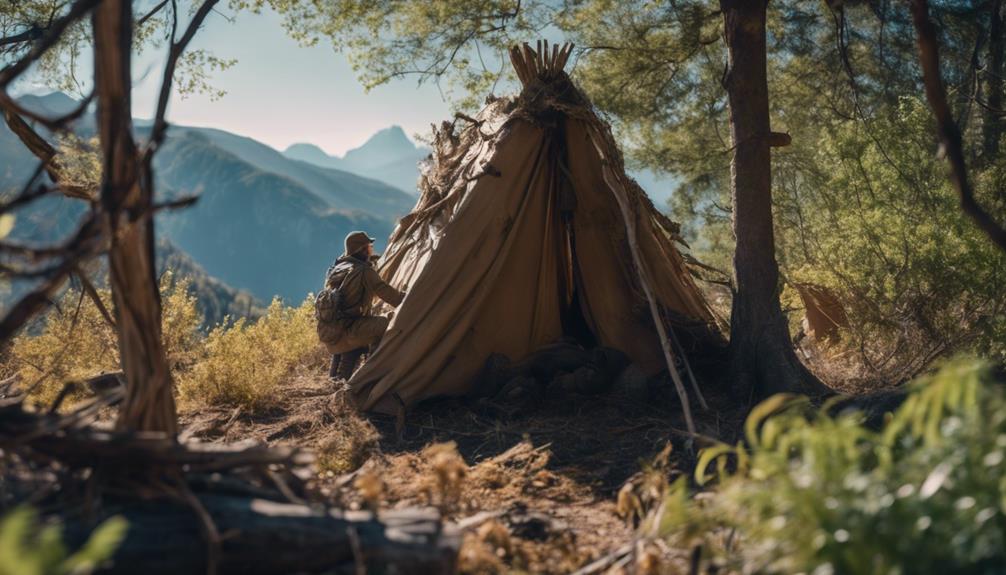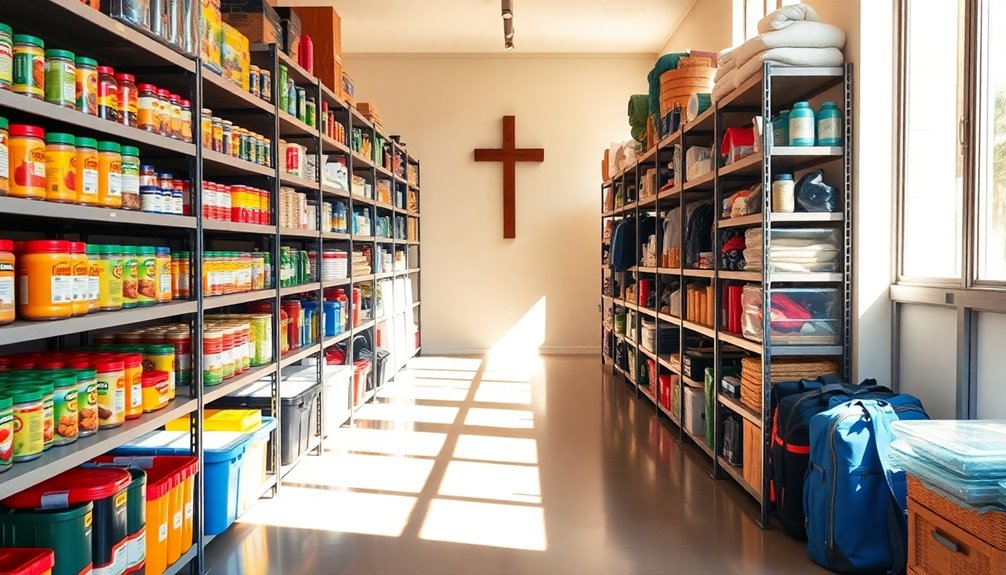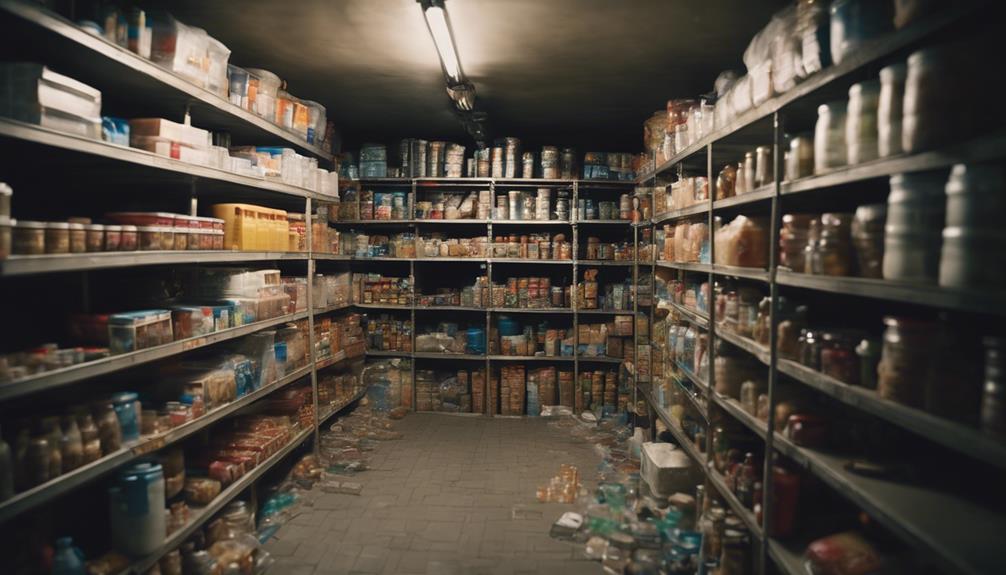When chaos strikes, being ready with essential SHTF supplies is crucial! You'll want to stock up on clean water, non-perishable food, and a well-equipped first aid kit. Don't forget hygiene items and personal protective gear, like masks and gloves, to keep yourself safe. Having tools for communication, like radios, is also smart. Make sure your emergency kits are easy to grab and check them regularly. With a little preparation, you can stay safe and calm when unexpected things happen. Excitingly, there's even more to discover about what to include in your supplies!
Key Takeaways
- Ensure a reliable water supply by storing sanitized water in food-grade containers and rotating it every 6 months to 1 year.
- Stock up on non-perishable food items like canned goods and high-energy snacks, rotating supplies every couple of years for freshness.
- Assemble a comprehensive first aid kit with essential medical supplies, medications, and hygiene products, regularly updating it for readiness.
- Prepare a portable emergency kit containing communication tools, shelter items, and cooking supplies, ensuring easy access during crises.
- Build a local support network by organizing community meetings for preparedness training and establishing a communication plan for emergencies.
Essential Water and Hydration

Ensuring you have a reliable water supply is crucial during any crisis. Water is life! To stay safe, you should store water in cool, dark, dry places. This helps prevent bacteria from growing.
Use large, food-grade containers that aren't see-through. This keeps light out, stopping any chemical contamination. Before filling them, make sure to sanitize your containers. Just wash them with dish soap and a mix of bleach and water. Then, fill them with tap water, adding a couple of drops of bleach per gallon, and seal them tightly. Investing in a water filtration system can further ensure safe drinking water.
Don't forget to rotate your water every six months to a year to keep it fresh. If you need water in a pinch, boiling it for at least five minutes is a great way to kill germs. Climate conditions can affect how long you can survive without water, so always be prepared.
You can also collect rain or snow when it falls. Trees like maple can provide water, too! And if you're in a bind, you can melt ice for drinking.
Investing in a water filtration system or purification tablets can be a smart move, too! With these tips, you'll be ready to keep hydrated no matter what!
Non-Perishable Food Supplies
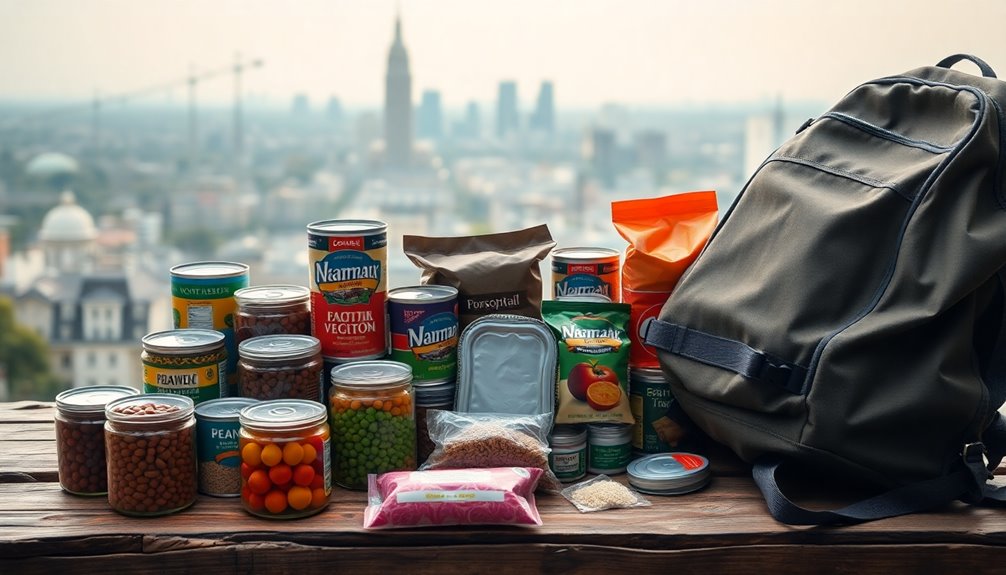
While staying hydrated is vital, having a stockpile of non-perishable food supplies is equally important for survival during a crisis. You want to be prepared, right?
Start by filling your pantry with canned fruits, vegetables, and meats. These foods last a long time and are easy to use! Don't forget about canned soups and broths for quick meals. Non-perishable foods can be stored safely at room temperature, making them ideal for emergency situations. Additionally, consider incorporating wood as a fuel source for cooking options, as it can provide heat and the ability to prepare meals during a power outage. Remember that having a proper budget for these supplies can help ensure you are financially prepared for emergencies. Moreover, ensuring that you have a solar-powered option for cooking can help reduce dependency on traditional fuel sources. It's also wise to keep in mind the importance of nutritional balance in your food selection to maintain health during prolonged emergencies.
High-energy snacks are also a must. Think about peanut butter, granola bars, and trail mix. They give you energy and taste great! Oats are another fantastic option, packed with fiber and vitamins.
And let's not overlook comfort foods! Cookies and sweetened cereals can lift spirits during tough times. Instant coffee or tea can make a big difference, too.
For long-term storage, rice and pasta are super choices, lasting many years. Cooking oils and flour are essential for cooking, so stock up on those as well.
Just remember to rotate these items every couple of years to keep everything fresh!
Medical Supplies and First Aid
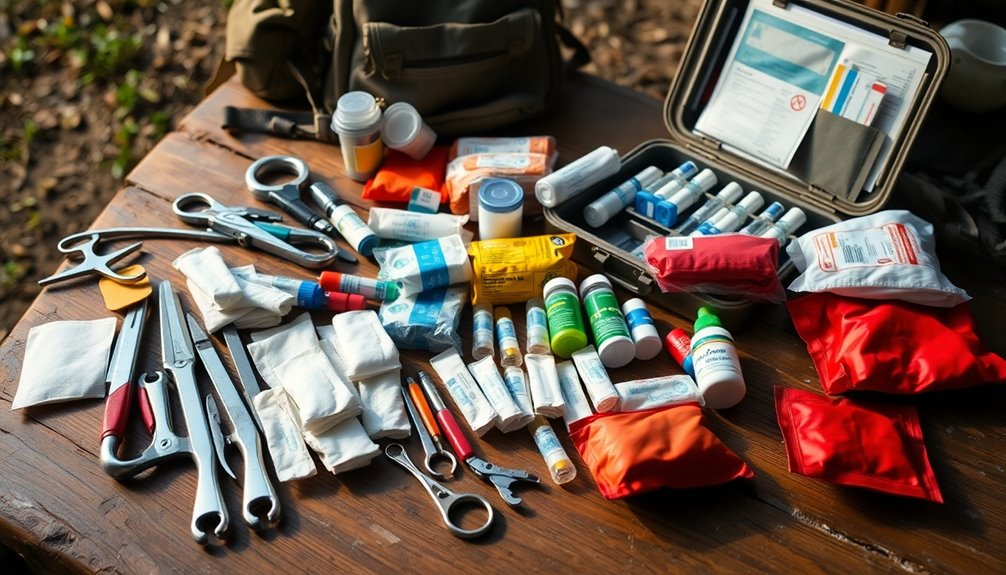
Your medical supplies and first aid kit can be lifesavers in a crisis, making it crucial to stock them properly.
Start with bandages in different sizes, like the Curad variety pack, so you're ready for any cut or scrape. You'll also want gauze rolls and non-adherent pads to keep wounds clean and protected. Regular outings for puppy socialization can help ensure your dogs remain calm during stressful situations, making it easier to care for them in emergencies. Additionally, having low furniture in your living space can create a safer environment for both children and pets during chaotic times. Understanding basic first aid knowledge is essential for effectively using your supplies, as it empowers individuals to respond appropriately to injuries and emergencies.
Don't forget wound closures like Steri-Strips and butterfly bandages for those tougher injuries. For larger wounds, have ABD pads and Kerlix on hand. SAM splints are great too, as they can help stabilize broken bones.
Next, include essential medications. Oral antibiotics and antibiotic ointments can fight infections, while pain relievers and antihistamines keep discomfort at bay. Antiseptic sprays and alcohol are perfect for cleaning wounds. Regular assessments of your first aid kit ensure that all supplies are up to date and ready for emergencies.
For monitoring health, a digital thermometer and pulse oximeter can help you keep track of vital signs, which is crucial for identifying any late effects of breast cancer that may arise post-treatment. And when emergencies hit, tourniquets and CPR masks are essential for saving lives.
Finally, pack hygiene items like medical gloves and hand sanitizer. This way, you'll be prepared for anything that comes your way, keeping yourself and others safe!
Personal Protective Equipment
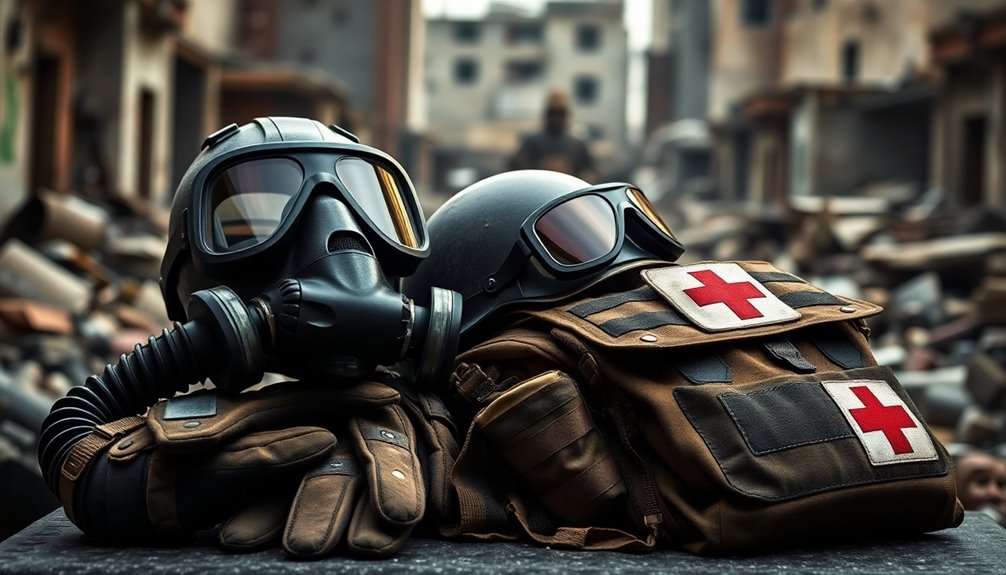
After you've stocked your medical supplies and first aid kit, it's time to focus on Personal Protective Equipment (PPE). This gear is essential for keeping you safe when chaos strikes.
First, think about face masks. N99 masks filter out 99% of airborne particles, helping you breathe easier in tough situations. Face shields are great too; they protect your eyes from germs and bacteria.
Don't forget about gloves! Disposable latex or nitrile gloves keep your skin safe from infectious materials.
And for full-body protection, CDC-compliant gowns are a must. Hair nets are also handy, preventing hair contamination.
Remember, some PPE items are single-use, like masks, gowns, and gloves. Others, like plastic face shields and washable masks, can be reused. Always dispose of single-use items properly to stay hygienic, and regularly clean your reusable gear. Additionally, having a comprehensive first aid kit is crucial to complement your PPE and enhance your safety in emergencies.
Make sure to include PPE in your SHTF emergency kit. Store it where you can grab it quickly, and have enough for everyone in your family.
Practice using your PPE during drills so everyone knows how to put it on and take it off safely. Stay prepared, and you'll feel more confident when chaos hits!
Communication and Shelter Tools

Effective communication and reliable shelter tools are crucial for survival during any crisis. You want to stay connected with loved ones and have a safe place to be.
First, think about your communication methods. While cell phones are great, they can fail when you need them most. Consider backup options like two-way radios or even satellite phones, which work independently of local networks. Don't forget simple tools like whistles or mirrors for signaling! Establishing a reliable communication plan that includes alternative methods is essential to ensure you can connect during emergencies.
Now, let's talk about shelter. Sheltering in place can be a smart choice during short-term crises. Stock up on non-perishable food, water, and first aid supplies.
If you need to evacuate, have a bug-out plan ready. Know safe locations and pack essential emergency kits. It’s also wise to have written instructions, especially for friends or family who might struggle with technology. Don’t forget to include bugout bag essentials such as non-perishable food, water, a first-aid kit, flashlights, batteries, and any necessary medications. It’s important to regularly check and update your bugout bag to ensure everything is still in good condition and hasn’t expired. Having a well-prepared bugout plan can make all the difference in a high-stress situation.
Lastly, think long-term. Prepare for days or weeks without help by building community support. Stay informed with local news, and practice your communication plan regularly.
With the right tools and preparation, you can face any situation with confidence and hope!
Frequently Asked Questions
How Can I Purify Water if I Run Out of Purification Tablets?
If you run out of purification tablets, don't worry! You can purify water by boiling it. Just bring clear water to a rolling boil for at least five minutes.
If the water's cloudy, filter it first. Another option is distillation, which involves heating water until it turns to vapor and then cooling it back into liquid.
You can also try using plants with natural purifying properties, like citric fruits.
Stay safe and hydrated!
What Are the Best Non-Perishable Food Options for Children?
When you're choosing non-perishable food options for children, think about yummy choices! Canned fruits like peaches and mandarin oranges are sweet and easy to eat.
Protein-packed options like canned chicken or beans are great for growing kids. Don't forget fun snacks like granola bars and nut butters!
Instant oatmeal and mac and cheese make quick meals. With these tasty foods, your kids will stay happy and energized, no matter the situation!
How Do I Create a First Aid Plan for My Family?
Creating a first aid plan for your family is fun and important!
Start by gathering essential supplies like band-aids, antiseptics, and pain relievers. Don't forget to include a first aid manual!
Next, learn basic first aid skills, like CPR.
Set up a communication plan and choose a meeting spot in case you get separated.
Finally, practice your plan regularly so everyone knows what to do.
You'll feel more confident and ready for anything!
What Should I Include for Pet Emergency Supplies?
When preparing for your pet's emergency needs, gather food and water in waterproof containers.
Include their favorite toys and treats to keep them comfortable.
Don't forget a first-aid kit with bandages and antiseptic!
Make sure your pet has a collar with an ID tag, and keep vaccination records handy.
A cozy blanket or shirt can help ease their stress.
Finally, pack a sturdy carrier for safe transportation.
Your furry friend will appreciate it!
How Can I Stay Informed During a Crisis Without Electricity?
To stay informed during a crisis without electricity, you can use a hand-crank radio. It doesn't need power, and you can listen to news and updates.
Shortwave radios are great too! They pick up information even when other signals are down.
Consider keeping a notebook to jot down important details.
Also, signal mirrors and whistles can help communicate with others nearby.
Planning ahead makes all the difference, so you're ready when it counts!
Conclusion
Now that you know the must-have supplies for when chaos strikes, you're ready to tackle any situation! Remember, staying prepared is key to feeling safe and secure. Gather your water, food, medical supplies, and protective gear. Don't forget about communication tools too! When you're organized, you can face challenges with confidence. So, take a deep breath, smile, and start collecting your supplies today. You've got this, and your future self will thank you!

